
HEND (High-Energy Neutron Detector) is a Russian experiment as part of the GRS instrument aboard NASA 2001 Mars Odyssey orbiter.
Russia's participation in the 2001 Mars Odyssey project is defined in the Executive Agreement between NASA and the Federal Space Agency (now State Space Corporation ROSCOSMOS) that was the customer of the HEND instrument developed and manufactured at Space Research Institute of the Russian Academy of Sciences.
Scientific Goals
- to measure the absolute value of fast neutron fluxes from Mars in different spectral bands;
- to map water-bearing areas on the surface of Mars and determine the mass fraction of water ice and chemically bound water, as well as to estimate the depth of water-bearing layers;
- to monitor seasonal variations of the neutron albedo of Mars over the polar regions of the planet and determine the surface density and composition of the seasonal cover of the poles (based on models);
- to carry out temporal and spectral analysis of solar events during the cruise to Mars and in the orbit, to build a stereoscopic image of individual solar events (using with data from other projects);
- to register gamma-ray bursts: HEND is a part of the international triangulation network to determine the coordinates of transient sources (InterPlanetary Network, IPN).
Mission Overview
HEND is a Russian neutron detector integrated into the Gamma Ray Spectrometer (GRS) of the NASA's 2001 Mars Odyssey Orbiter.
The HEND neutron detector records the flux of secondary neutrons emitted from the Mars surface — so-called neutron albedo. This value is essential for the main goal of the GRS experiment (of which HEND is a part) that is to study mineralogical composition of the Martian surface.
In the GRS experiment the data on neutron flux from the Mars surface are mostly auxiliary. But to determine how much hydrogen and water there are in the Martian surface and subsurface HEND data only are sufficient.
Martian albedo neutrons are born in the subsurface layer 1–2 meters thick in the interactions with cosmic rays and during the decay of natural radioactive elements. On their way to the surface, these neutrons are slowed down and absorbed by the nuclei of the main rock-forming elements. Thus, the neutron flux coming out of the ground depends on composition of the latter and first of all on the presence of hydrogen or hydrogen-bearing compounds. Knowing hydrogen distribution in the ground, one may judge about the presence of water ice or bound water in minerals there.
Furthermore, it is known that the atmosphere of Mars experiences seasonal fluctuations. In autumn and winter about a quarter of all atmospheric carbon dioxide is condensed on the surface of the polar regions of Mars. A layer of deposited carbon dioxide can be from several tens of centimeters to one meter thick, so that carbon dioxide ice can completely cover water ice that makes up the polar caps of the planet. So, one can use neutron spectroscopy to observe seasonal cycles on Mars and to determine thickness of the seasonal cover of deposited carbon dioxide.
As the results of many-year-work on the basis of HEND data maps were derived, which show distribution of water ice in the Martian subsurface and variations in the content of deposited carbon dioxide in the polar regions of the planet. The results of the HEND experiment were used to select a landing site for the Curiosity rover with a DAN neutron detector onboard. Gale Crater, where the rover was descended, is near Arabia Terra. According to HEND, hydrogen content of the ground here exceeds 7% by mass. However, according to the results of neutron sounding, which has been carried out by DAN since 2012, Gale crater appeared to be a very dry place: the percentage of water ice by mass in most points along the rover's route does not exceed 1–2%. This apparent contradiction in observations are now being studied by the FREND instrument of the ExoMars-2016 mission, which, like HEND, operates in orbit, but has a much better spatial resolution up to 40 km (versus 100 km for HEND).
The instrument includes four independent detectors:
- three epithermal neutron detectors: SD, MD, LD — proportional gas counters based on 3He;
- high energy neutron detector (SC) made of C14H12 stilbene, surrounded by an active anti-collision shield made of CsI:Tl3+ crystal.
Main parameters
- Detected neutrons energies: 0.4 eV–14 MeV
- Temporal resolution: variable, >1 s
- Spatial resolution (on the surface): ~100 km on 50 km high orbit
- Vertical resolution (maximal penetration depth): ~1–2 m
Leading Organizations and Principal Investigators
- State Space Corporation ROSCOSMOS
- Space Research Institute of the Russian Academy of Sciences (IKI)
- Principal Investigator of the HEND experiment: Dr. Igor G. Mitrofanov (IKI)
In Collaboration With
- Joint Institute for Nuclear Research (JINR, Dubna, Moscow region)
- Mechanical Engineering Research Institute, RAS (IMASH RAN)
- All-Russian Scientific-research Institute of Mineral Resources named after N.M. Fedorovsky (VIMS)
- Specialized Scientific Research Institute for Instrumentation Engineering (SNIIP)
- University of Arizona (UofA, USA)
Websites
- The HEND experiment on the website of the IKI Nuclear Planetology Department
- The GRS experiment on the University of Arizona portal
- 2001 Mars Odyssey on the NASA portal
Gallery
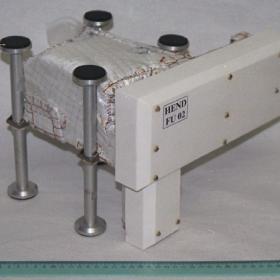
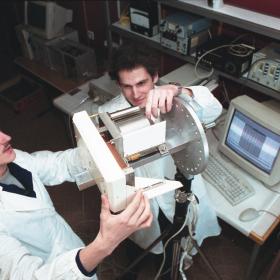

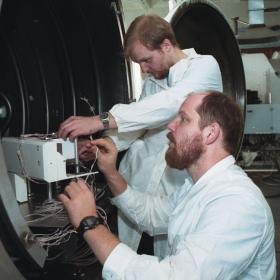
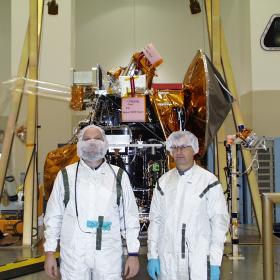
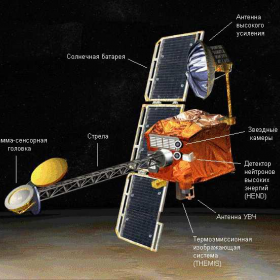
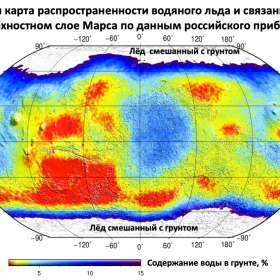
2001 Mars Odyssey
Status: in operation
Launch: 07.04.2001, 15:02:22 UTC, Cape Canaveral Spaceport, Delta II
Leading space agency: NASA
SCN: 26734
NSSDC ID: 2001-013A
Main website: 2001 Mars Odyssey
HEND / ХЕНД
Status: in operation
Leading space agency: ROSCOSMOS
Main website: Russian neutron detector HEND for the NASA space mission 2001 Mars Odyssey
